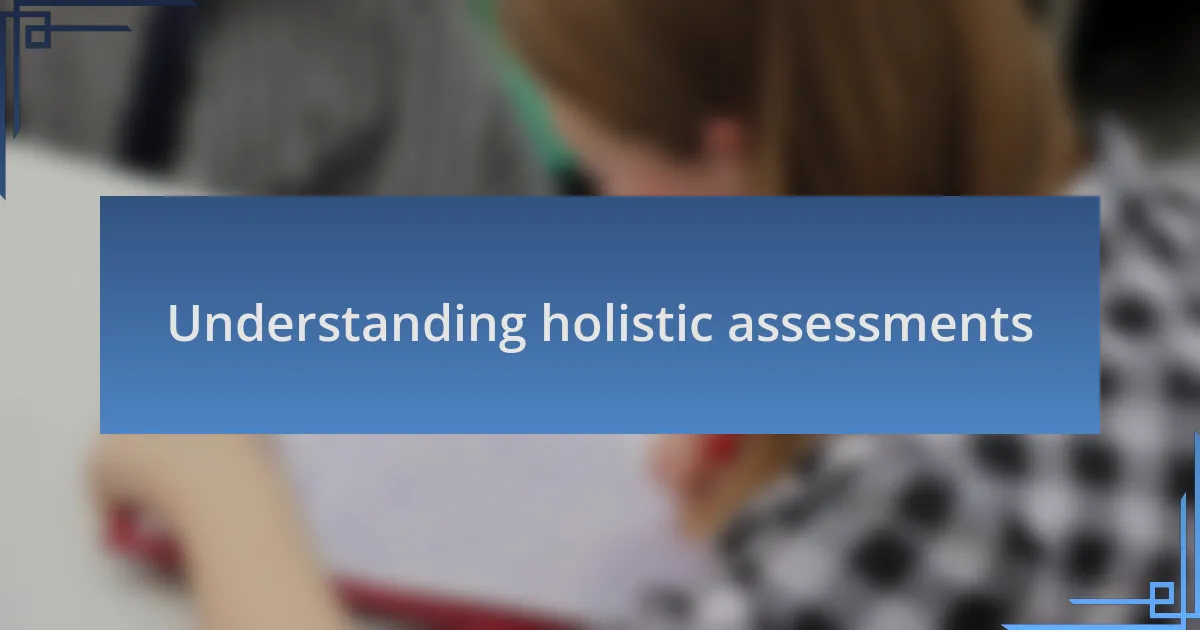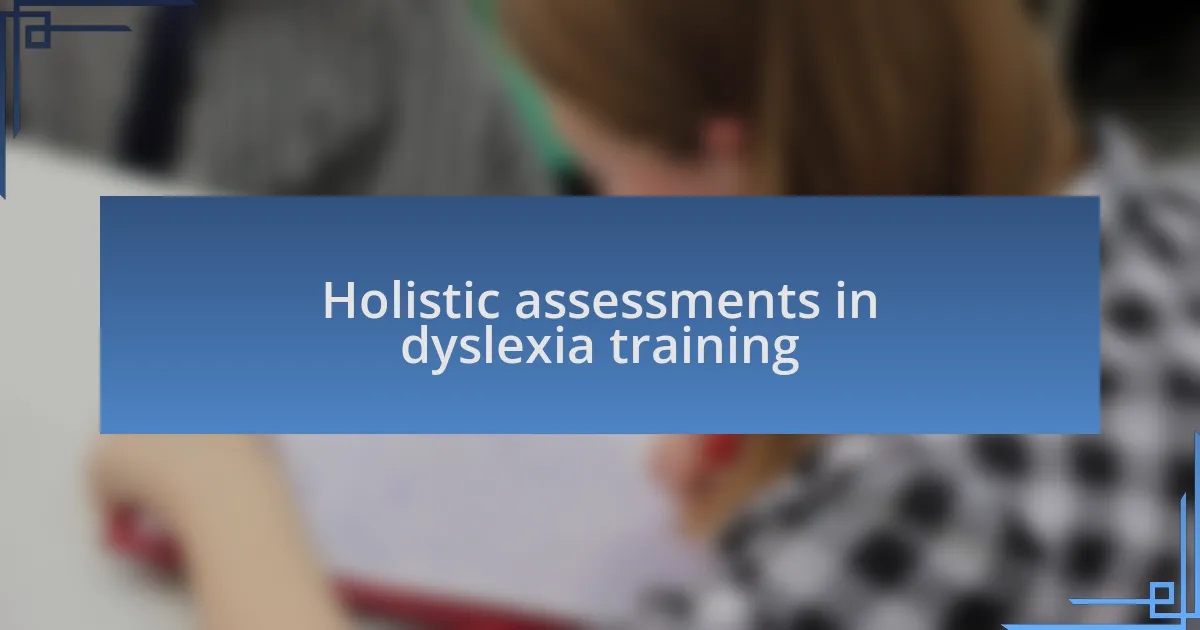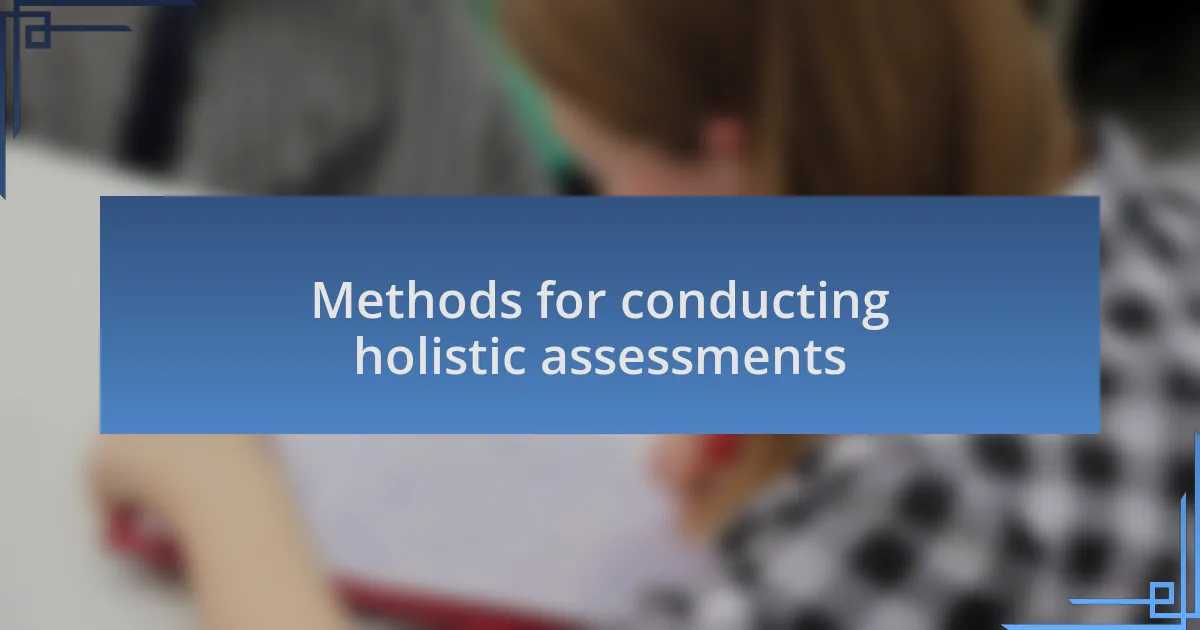Key takeaways:
- Holistic assessments consider emotional, social, and academic factors, providing a comprehensive view of a learner’s abilities.
- These assessments foster collaboration among educators, parents, and specialists to identify unique strengths and challenges.
- Integrating emotional insights can enhance academic performance, as addressing a student’s emotional state often leads to improved learning outcomes.
- Creative expression and open dialogue with students encourage self-awareness and reflection, empowering them in their educational journey.

Understanding holistic assessments
Holistic assessments provide a comprehensive view of an individual’s abilities, considering not just academic skills but emotional and social aspects as well. I remember when I first encountered this approach; it felt like a breath of fresh air, enabling me to see students beyond their scores and challenges. Have you ever thought about how much a person’s environment and emotional state impact their learning?
These assessments often incorporate diverse tools, such as interviews and observations, allowing for a richer understanding of each learner’s unique needs. For me, observing a student excitedly engage in a project can reveal more than any standardized test ever could. It’s moments like these that remind me that intelligence and potential aren’t always measured by conventional metrics.
Moreover, using a holistic approach encourages collaboration among educators, parents, and specialists. I once facilitated a meeting where insights from various contributors painted a complete picture for a struggling student. It struck me how powerful it is when we all come together, each offering pieces of the puzzle that a single test would miss.

Importance of holistic assessments
Holistic assessments are crucial because they reveal the interconnectedness of a learner’s strengths and challenges. I once worked with a child who excelled in artistic expression but struggled with reading. By employing a holistic approach, I could appreciate how their creativity informed their learning style. How often do we overlook these multifaceted capabilities in traditional assessments that focus solely on academics?
Furthermore, holistic assessments foster a deeper connection between educators and students. I vividly recall a conversation with a young student who was reluctant to share their thoughts in class. Through observation, I discovered that their hesitation stemmed from anxiety about being judged. This insight transformed my approach, allowing me to create a more supportive learning environment. Isn’t it fascinating how understanding a student’s emotional landscape can open doors to their academic success?
Lastly, these assessments encourage lifelong learning by nurturing self-awareness in students. During a recent workshop, a participant shared how reflecting on their emotional responses to assessments helped them develop resilience. This kind of growth is invaluable; when students understand their learning preferences and emotional triggers, they become proactive in their education. Can you imagine the empowerment that comes from knowing oneself in this way?

Holistic assessments in dyslexia training
Holistic assessments in dyslexia training allow for a comprehensive view of a learner’s abilities and needs. I remember working with a teenager who struggled with traditional literacy tasks yet demonstrated remarkable verbal skills during discussions. This revelation made me realize that recognizing and harnessing their verbal strengths could significantly enhance their reading experience.
In my experience, integrating emotional and social factors into assessments has proven invaluable. I once assessed a student whose low performance in reading was exacerbated by external pressures, not just their dyslexia. Once we addressed the emotional hurdles, their confidence surged, leading to tangible progress in their reading ability. Isn’t it enlightening how addressing emotional well-being can directly influence academic performance?
The feedback from parents during these holistic assessments has also been eye-opening. One mother shared how her child, who had previously felt alienated in school, found a sense of belonging through tailored support that acknowledged their unique strengths. It’s moments like these that remind me how essential it is to view students as whole individuals, rather than just problem areas to be fixed.

Methods for conducting holistic assessments
When conducting holistic assessments, I often begin with structured interviews that delve deeply into the learner’s experiences. I recall one instance where a simple question about their favorite hobbies revealed a wealth of information about their strengths and interests, which I could then connect back to their learning. Isn’t it fascinating how our interests can guide our learning pathways?
Incorporating various assessment tools, such as observations during interactive tasks, allows for a well-rounded view of a student’s capabilities. I once observed a child navigating a group project, and it became clear how their collaborative skills could be leveraged to tackle reading challenges. This approach reminded me how important it is to recognize a student’s social interactions alongside their academic struggles.
Additionally, integrating input from teachers and family provides critical context. I remember collaborating with a teacher who noted that a student often excelled in verbal group settings but struggled in one-on-one reading exercises. Together, we created a tailored strategy that built on the student’s strengths, illustrating how collective insights can lead to breakthrough moments. Doesn’t it make you think about the collective knowledge we often overlook when assessing a learner’s abilities?

My approach to holistic assessments
When I approach holistic assessments, I prioritize creating a safe space for learners to share their thoughts. I recall working with a young student who was initially anxious about sharing his struggles with reading. Through a casual conversation over a shared snack, he opened up about his love for storytelling, which I later wove into our reading sessions. Can you see how vital it is to address emotional barriers to unlock a student’s potential?
I also find that incorporating creative expression, like drawing or journaling, gives students a different outlet to communicate their experiences. One time, a student created a comic strip about her frustrations with letters that seemed to dance on the page. This insight was pivotal, illuminating the emotional side of her learning challenges. Don’t you think that understanding a student’s feelings can enhance our approach to helping them?
Lastly, I strive to maintain an ongoing dialogue with students that encourages reflection. I often ask them how they feel about their progress after each assessment cycle. When a student once expressed pride in mastering new vocabulary, it reinforced my belief that self-advocacy can be empowering. How can we help learners recognize their achievements and motivate them to continue improving?

Practical tips for effective assessments
When conducting assessments, I suggest using varied methods to capture a fuller picture of a student’s abilities. For instance, I once mixed traditional reading tests with oral storytelling. A student who struggled with written language flourished when I allowed him to narrate his story aloud. Isn’t it fascinating how changing the medium can reveal hidden strengths?
I also believe in the power of setting realistic goals tailored to each learner’s needs. I remember guiding a student who felt overwhelmed by the idea of reading a full chapter. We broke it down into smaller, manageable sections, celebrating each part he completed. This not only eased his anxiety but also built his confidence. Have you experienced how small victories can create a ripple effect in a student’s enthusiasm?
Another practical tip is to involve parents in the assessment process. I once held a workshop where parents could observe assessments in action. Their real-time feedback helped identify strengths and concerns that might have gone unnoticed. It’s a reminder that collaboration can deepen our understanding of a child’s learning journey, don’t you think?